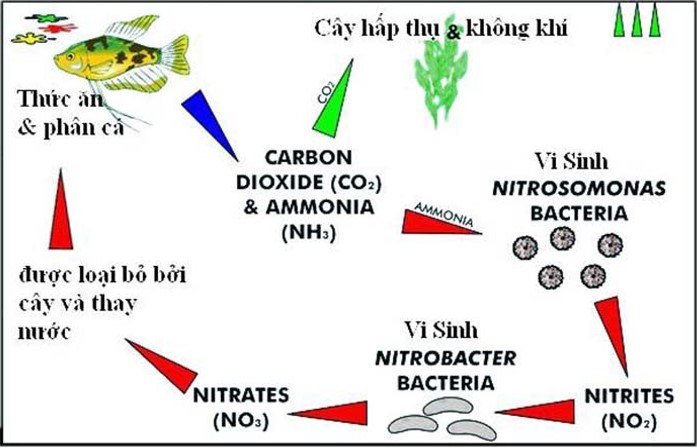With the development of fisheries currently, especially industrial shrimp farming with high technology, high density, and large output, the water environment in the pond is more polluted due to waste. Therefore, it produces a lot of diseases and toxic gases. Toxic gases such as NO2 and NH3 are the most concern. They have a harmful influence on the success of farming.
1/ The origin
NO2 originates from NH4+/NH3. Then, it goes through stage 1 of the process of nitrification and converts into NO2. In addition, it also comes from the water supply.

The process of producing toxic gas in shrimp and fish ponds
Causes: Microorganisms decompose the excess feed that accumulates at the pond bottom to form toxic gases such as NO2 and NH3, which pollute the water source. These are the most toxic gases for shrimp.
2/ The effects
+ Toxic gas is often focused at the bottom of the pond, making shrimp unable to eat the feed. As a result, shrimp have an empty gut, which reduces the growth of cultured shrimp.
+ When NO2 content is low in shrimp ponds, it seriously impacts shrimp. However, when NO2 is high, shrimp lose the ability to transport oxygen in the blood, causing them to die. When shrimp is weak, they will get diseases such as white feces, hepatopancreatic, white spot, muscle necrosis disease, or die due to environmental shock.
+ When the NO2 content is too high in the pond, the shrimp will float on the surface. In addition, it may die in small or large numbers in the early morning and late evening.
+ Toxic gases such as NO2 and NH3 cause disturbance of osmotic pressure balance with signs including molting but softshell, slow growth, damaged gills, and muscle necrosis.
3/ Treatments
+ Changing the water from 50-70% if the water source is available.
+ Using probiotics or products containing Lactobacillus strains to inhibit the growth of Vibrio and effectively reduce NO2 content in shrimp ponds. Dosage according to the instructions on the package.
+ Using probiotics to effectively treat pond bottom, stabilize toxic gas concentrations, and decompose excess feed and waste. It helps avoid the formation of toxic gas like NH3 in shrimp ponds.
+ Combining with siphon the pond bottom to bring better efficiency and limit the production of toxic gas. It helps reduce the decomposition of waste, mud, and excess feed. In addition, it also creates a favorable environment for shrimp to reach the pond bottom to limit leftovers.
+ Strengthening paddle wheels and oxygen system to diffuse toxic gases, especially in hot weather and strong wind.
+ Periodically supplementing lime 3 days per time to strengthen the buffer system and stabilize the alkalinity. Adding lime when it rains a lot.
+ Maintaining the growth of algae in the pond at an appropriate level to avoid the occurrence of algal blooms or low-density algae in the pond. Stabling pH from 7.5-8.3.
+ Managing feeding closely, avoiding overfeeding, and causing pollution.

 Tiếng Việt
Tiếng Việt 中文 (中国)
中文 (中国)